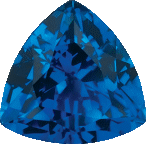| |
Sapphire
|
Sapphire is the common name for corundum. The name sapphire originates from the Hebrew sapphir meaning most beautiful of things. It should be noted however that the sapphir of the early Hebrews was the stone we know of as lapis lazuli. The name was transferred to blue corundum some time in the medieval era, and from there came to mean all forms of corundum as they were discovered to be related materials.
The use of sapphire in wedding rings predates the diamond, and has historically been seen as a symbol of fidelity and consistency. It was not until a very successful campaign by De Beers that the diamond became associated with femineity and weddings.
Though usually thought of as a blue gem, sapphires occur in all colors except red. The red variety of corundum is defined separately as ruby. How cultures interpret “red” influences the identity of the ruby or sapphire. In the west pink is considered a separate color, and so we have pink sapphires. But in the east pink is a shade of red, and so the same stone would be considered a pigeon blood ruby due to cultural perceptions. This was likely because the ruby already held a place in cultural ideology that was separate and distinct from the sapphire, and the other colors of sapphires were often mistaken for gems of the same shades. So, when the error was discovered, the other colors became associated with the least cognitively entrenched version of corundum.
The heavenly blue color earned the stone a sacred reputation in folklore. By the 12th century it had found a place on the fingers of cardinals as rings of office. It was said to be the Stone of Truth, and was bestowed with the ability to dispel delusion and allow the wearer to see through deception. This stone was thought to be so holy that it could strike down venomous creatures and cause evil spirits to flee at the sight of the gem.
Strangely, the sapphire was also much sought after by practitioners of the magical arts. Necromancers believed it could control spirits. Sorcerers and soothsayers believed the sapphire could render obscure prophecies comprehensible. And Bartolomaeus claimed that witches “worked certain wonders by virtue of this stone”.
The star sapphire is a variety of sapphire that exhibits a star when cut en cabochon. The three lines of the star represented faith, hope, and destiny, the last of which earned the star sapphire the title of "The Stone of Destiny". In addition to magnifying the virtues of the regular sapphire the star sapphire could also render the wearer immune from all enchantment, quill enemies, and undo chains and bonds so that the wearer could not be held captive.
|
Colors
|
Any color except red
|
Locations
|
Australia, Brazil, Burma, China, Egypt, Norway, Pakistan, and the USA
|
Compisition
|
Al2O3, Aluminum oxide
|
Hardness
|
9
|
|

|

|

|
|
|
|
|
|